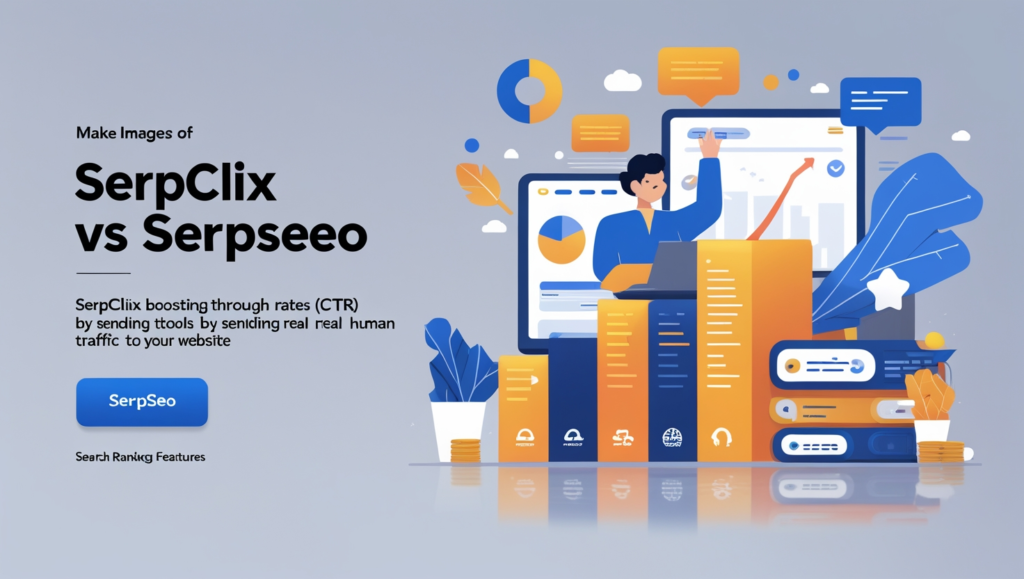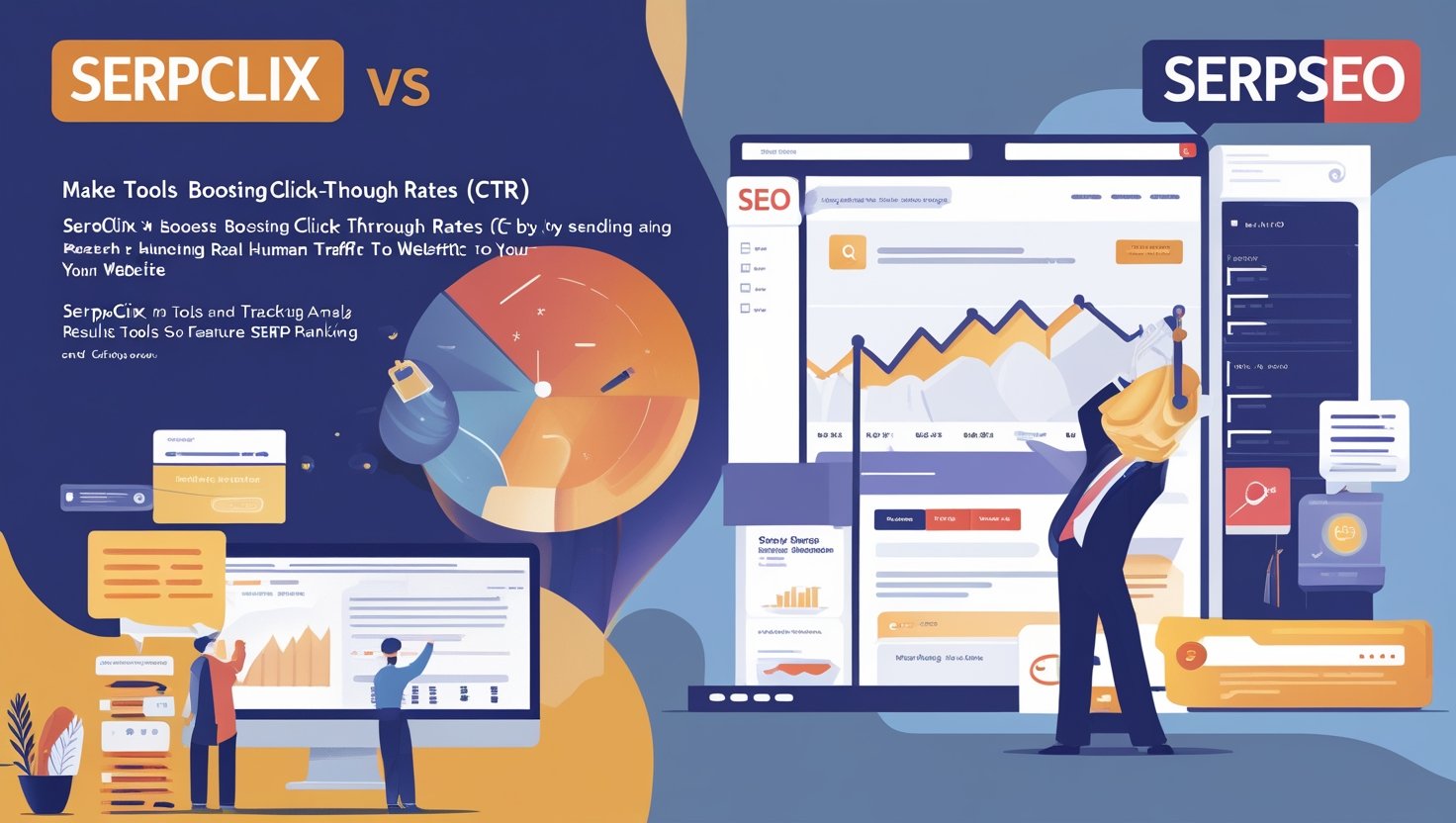Choosing the right tool can make all the difference when it comes to improving your website’s performance on search engines. Two popular options you might come across are SerpClix and Serpseo. Both are designed to help with search engine optimization (SEO), but they take very different paths to get there. SerpClix is all about boosting your click-through rates (CTR) by sending real human visitors to your site.
On the other hand, Serpseo focuses on giving you tools to track and analyze your rankings on search engine results pages (SERPs). So, which one is better for you? Let’s break it down in this easy-to-read guide.This article will dive deep into SerpClix vs Serpseo, explaining what each tool does, how they work, and what they’re best for. We’ll keep it simple so anyone can follow along—whether you’re new to SEO or a seasoned pro.
What Is SerpClix?
SerpClix is a tool built to bump up your website’s click-through rate, or CTR. That’s the percentage of people who click on your site after seeing it in search results. Why does this matter? Search engines like Google look at CTR as a sign of how helpful your site is. If more people click it, Google might think it’s worth showing higher up on the list.
Here’s how SerpClix works: it hires real people—called “clickers”—to search for specific keywords you choose, find your site in the results, and click on it. These aren’t bots or fake traffic; they’re actual humans worldwide, making the clicks look natural. You tell SerpClix which keywords to target, and they send these clickers to your site through Google searches. The idea is to trick search engines into thinking your site is super popular, which could push your rankings higher.
It’s a straightforward setup. You sign up, pick your keywords, decide how many clicks you want, and pay per click. It’s fast and focused, perfect if you’re trying to boost a specific page or keyword quickly.
What Is Serpseo?
Serpseo takes a different approach. Instead of sending traffic to your site, it’s a tool that helps you understand how your site is doing on search engines. It’s all about tracking and analyzing your rankings on search engine results pages—those lists you see when you Google something. Serpseo gives you the data you need to figure out what’s working and what’s not.
With Serpseo, you can see where your site lands for specific keywords, watch how those rankings change over time, and even peek at what your competitors are up to. It’s like a dashboard for your SEO health. You get reports on things like your position on the SERP, how visible your site is, and what features—like snippets or ads—are showing up alongside your listing. It’s less about quick fixes than building a long-term plan to climb the ranks.
You set it up by adding your website and the keywords you care about. Then, Serpseo monitors them, giving you updates and insights. It’s a tool for people who want to dig into the numbers and make smart moves based on real information.

How SerpClix Boosts Your SEO
SerpClix is laser-focused on one thing: getting more clicks to your site. The logic is simple—when more people click your link in search results, it signals to Google that your site is relevant and helpful. Higher CTR can sometimes nudge your site up the rankings, especially for keywords that aren’t super competitive.
The process starts when you give SerpClix your target keywords and website URL. Their network of over 100,000 clickers—real people, not robots—then goes to work. These clickers search your keywords on Google, find your site, and click it. They stay on the page for a short time (usually 30-60 seconds) to make it look legit. You can even pick where the clicks come from, like the U.S. or Europe, to match your audience.
It’s a fast way to see results. Some users say they’ve jumped a few spots on Google within weeks. But it’s not a magic wand—your site still needs good content to hold its place. SerpClix is like a short-term boost to get you noticed.
How Serpseo Improves Your SEO
Serpseo is more of a slow-and-steady tool. It doesn’t drive traffic to your site directly—it helps you understand your current SEO performance so you can improve it. Think of it as your SEO coach, giving you the stats and advice to win the game.
Once you plug in your site and keywords, Serpseo tracks where you rank on Google or other search engines. It shows you daily updates to spot trends—like if you’re climbing or slipping. It also digs into SERP features, like whether your site appears in “People Also Ask” boxes or image results. Plus, it lets you spy on competitors, showing you their rankings and strategies.
The real power comes from using this data. If you see a keyword dropping, you can tweak your content or add links to push it back up. Serpseo is about planning and fixing, not just hoping for a quick bump.
Key Differences Between SerpClix and Serpseo
So, what sets SerpClix and Serpseo apart? It’s all about their focus and style. SerpClix is a traffic tool that sends real clicks to your site to boost CTR and, hopefully, your rankings. Serpseo is an analysis tool that gives you the numbers and insights needed to improve your SEO over time. Here’s a quick rundown:
- Goal: SerpClix aims for fast CTR increases; Serpseo aims for long-term ranking growth.
- Method: SerpClix uses human clickers; Serpseo uses data tracking.
- Speed: SerpClix can show results in days; Serpseo takes weeks or months to pay off.
- Control: SerpClix lets you pick keywords and locations; Serpseo allows you to analyze and adjust.
If you want a quick lift, SerpClix is your pick. If you’re in it for the long haul, Serpseo’s your match.

Pros and Cons of SerpClix
Let’s weigh the good and the bad of SerpClix.
Pros
- Real Traffic: Uses actual people, not bots, so it looks natural to Google.
- Quick Results: Some users see ranking jumps in just a few days.
- Easy to Use: Simple setup—pick keywords and pay for clicks.
- Targeted: You can choose where clicks come from, like specific countries.
Cons
- Short-Term: Rankings might drop once you stop paying for clicks.
- Risky: Google could flag it as unnatural if overdone.
- Cost Adds Up: Paying per click can get pricey over time.
- Limited Scope: Only boosts CTR, not other SEO factors like content quality.
SerpClix is excellent for a fast push but won’t fix everything independently.
Pros and Cons of Serpseo
Now, let’s look at Serpseo’s ups and downs.
Pros
- Deep Insights: Tracks rankings and SERP features for thoughtful planning.
- Long-Term Value: Helps you build lasting SEO improvements.
- Competitor Info: Shows what others are doing so you can compete.
- No Risk: It doesn’t manipulate traffic, so it’s safe from penalties.
Cons
- Slower Results: It takes time to see ranking changes.
- Learning Curve: Requires some SEO know-how to use well.
- No Traffic Boost: Don’t send clicks to your site directly.
- Subscription Cost: Monthly fees can pile up.
Serpseo is a solid choice if you’re patient and want to grow steadily.
Pricing: SerpClix vs Serpseo
Money matters, so let’s talk about costs. SerpClix runs on a pay-per-click model. You buy credits, and each click costs between $0.10 and $0.50, depending on location and competition. A small campaign might run you $50 for 100 clicks, while bigger ones could hit hundreds. It’s flexible—you only pay for what you use.
Serpseo uses a subscription plan. Prices typically start around $20-$30 monthly for basic tracking (a few keywords) and go up to $100+ for advanced features like competitor analysis and more keywords. You pay monthly, whether you use it entirely or not.
SerpClix is cheaper for quick tests; Serpseo costs more but offers ongoing value.

Who Should Use SerpClix?
SerpClix is perfect for:
- Small businesses need a quick ranking boost for a new product.
- Bloggers targeting low-competition keywords to get noticed.
- Anyone testing SEO tactics without a big budget.
- Sites with solid content need more clicks to shine.
It’s best when you want fast visibility and have a page ready to impress.
Who Should Use Serpseo?
Serpseo fits:
- Website owners planning long-term SEO growth.
- Marketers who love data and want to tweak strategies.
- Businesses tracking multiple keywords or competitors.
- Anyone avoiding risky traffic tricks.
It’s ideal if you’re serious about steady progress and understanding your SEO.
Can You Use Both Together?
Here’s a thought: why not use SerpClix and Serpseo together? It’s doable! Start with SerpClix to give your site a quick CTR boost, then switch to Serpseo to track the results and keep improving. SerpClix gets you in the game; Serpseo helps you stay there. Be careful not to over-rely on clicks—balance it with good content and links.
Risks and Rewards
Both tools have risks and rewards. SerpClix’s reward is quick ranking gains, but the risk is Google spotting the paid clicks—though their human traffic lowers that chance. Serpseo’s reward is safe, steady growth, with the “risk” being slower progress. Your choice depends on how fast you need results and how much risk you’re okay with.
Real-World Examples
Imagine a small online store selling handmade mugs. They use SerpClix to target “unique coffee mugs” and jump from page 2 to page 1 weekly. But without great content, they slip back. Now, picture a travel blog using Serpseo. They track “best hiking trails” and see they’re stuck at #15. They tweaked their page based on Serpseo’s data and climbed to #5 over the months. Both work—just differently.
Final Thoughts: SerpClix or Serpseo?
So, which one will win, SerpClix vs. Serpseo? It depends on you. SerpClix is your go-to for a fast, affordable CTR lift—great for short wins or small budgets. Serpseo is the pick for deep analysis and lasting SEO success, perfect if you’re in it for the long run. Both are solid tools, just with different strengths.
Need a quick push? Try SerpClix. Want to build a strong foundation? Go with Serpseo. Or mix them for the best of both worlds. Whatever you choose, pair it with great content, and you’ll be on your way to better rankings. Happy optimizing!
References
- Moz.com: Explains CTR’s role in SEO rankings.
- SearchEngineJournal.com: Covers tools like Serpseo for SERP tracking.
- SerpClix.com: Official site for their clicker details.
- Serpseo.com: Source for their feature list.





